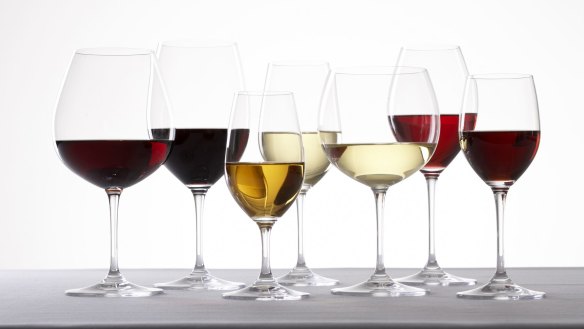What does the colour of a wine tell you?

First impressions count, and with wine that means colour.
With a vino in hand, the first thing we notice is its appearance. And, whether you're conscious of it or not, you're probably judging it before you've even had a sniff or a taste.
"That first look at the colour of a wine is really important," says Andrew Graham, from Sydney wine school The Tasting Glass.
"With reds, for example, you see a dark-coloured wine and you're already expecting it to be full-flavoured and intense.
"Some winemakers really chase that depth of colour, knowing that people see it and associate it with high quality straight away."
The colour of red wine
When it comes to colour, it's the red wines that give us the most readable clues about taste, quality and age.
"The different shades [of red] give you an indication of the variety, because you pick up the colour from the skins," Graham says.
"A shiraz will often start as a bright purple, a really beautiful and vibrant colour, while cabernet has a blue tinge to it – it's quite obvious which varieties they are from their colour."
These hues can often reflect the depth of flavour – but not always. Graham says, "Nebbiolo, for example, makes a light-coloured wine, but it's quite full-flavoured."
A red wine's tone also tells us a story about the drink's age.
The head winemaker at Leconfield Wines, Paul Gordon, says that as a red is being made, it looks vibrant and bright. "At vintage, the anthocyanins [natural colourants in grapes] are deep in colour: brilliantly red, and with a range of tones that make the winemaker's hands black as they handle the grape skins.
"At this stage the colour of the wine is influenced by the varietal and the size of the [grape]; a smaller grape will have a greater skin to juice ratio for more intensity of colour from the skins."
This bright scarlet continues into the bottle, and the colour begins to alter within the first 12 months.
"You'll see a change in the first year: a one-year-old wine is still bright but gives way to more brooding chocolate reds," Gordon says.
"Then the wine should become reasonably stable in colour, with the natural changes in the chemistry of the wine eventually leading to a bit of ochre after about five years."
The colour story of white wine
While the changes of colours in red wines are easier to notice and decipher, we shouldn't overlook white wines. There are still plenty of stories to be found within the tones of that crisp glass of white, for those who look a little more closely.
As Gordon explains: "As a general rule, lighter coloured white wines are likely to be lighter in style. Although there are some exceptions to that rule, like vermentino, which is a lighter colour, but has good mouth-feel and a rounder palate spectrum."
While reds take their colour from skins, a white's tone is more noticeable from the winemaking technique. "Chardonnay has a more pronounced yellow colour to it due to being aged in oak barrels," Gordon says.
And then there's the maturity level of the wine, which is where colour gives some bigger clues for the keen observer.
"Younger white wines have a green hue," Gordon says. "As a white wine ages, you see a change in the composition of those colours: an older white wine will become more golden. And if it still has a little of those green hues, that indicates it's still likely to have some freshness and vitality about it.
"A very old white wine may start to show some brown, which is an indication that a wine is becoming oxidised and, as a result, you start to lose some of those varietal characteristics and freshness."
If you're looking for something light with nibbles, Gordon suggests lighter coloured wines.
"If you're looking for something with a bit more depth and flavour, perhaps to pair with a meal, opt for a darker colour of wine, as it is more likely to be fuller and richer in flavour," he says.
Of course, it's quite difficult to assess the colour of a wine when it's still inside the bottle; it's only in the glass that all of these characteristics and clues become apparent. But, as Gordon says, this surprise is "a joy in life".
And, just like a book, we shouldn't judge a wine entirely by its cover – er, colour. Take a good look, and then try to enjoy the wine for its taste. Because, ultimately, flavour is king.